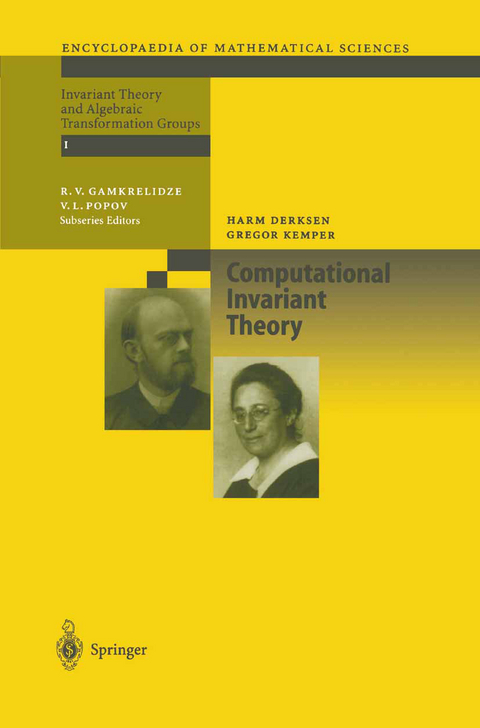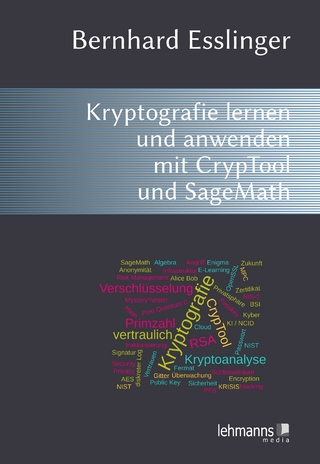
Computational Invariant Theory
Springer Berlin (Verlag)
978-3-642-07796-8 (ISBN)
1 Constructive Ideal Theory.- 2 Invariant Theory.- 3 Invariant Theory of Finite Groups.- 4 Invariant Theory of Reductive Groups.- 5 Applications of Invariant Theory.- A Linear Algebraic Groups.- References.- Notation.
From the reviews:
"... I found this book to be very impressive in its scope, accessibility and the quality of writing. ... There can be few readers, even amongst those with some prior knowledge of invariant theory, for whom several of these applications will not be new and impressive. ...
In summary, this beautifully produced book is highly recommended both for experts in invariant theory and newcomers to the field."
J.E.Cremona, Nieuw Archief voor Wiskunde 5/4 (2003), Issue 4
"... Ein besonderer Vorteil dieses Buches ist das reichhaltige Kapitel über Anwendungen. ...
Wie die Autoren formulieren, wendet sich das Buch an Forscher im Gebiet der Geometrie, Computeralgebra und der Invariantentheorie. Es kann aber sicherlich auch für ein Seminar verwendet werden, das auf eine einführende Vorlesung zur Computeralgebra aufbaut.
Da die Algorithmen zur Berechnung von fundamentalen Invarianten Gröbnerbasen und algorithmische kommutative Algebra verwenden, behandelt das erste Kapitel dieses Thema. Schon hier kann man bewundern, wie knapp, präzise und auf den Punkt genau die Autoren formulieren. ...
Insgesamt gesehen ist dies ein sehr schönes Buch. Einige der Resultate sind nie zuvor in Buchform erschienen. ...
Den einzigen Nachteil, den ich an diesem Buch finden kann, ist folgender: Ich hätte das Buch gern einige Jahre früher zum Lesen gehabt."
Karin Gaterman, Computeralgebra Rundbrief, März 2004
"... Dieses in wissenschaftlicher und didaktischer Hinsicht vorzügliche, übersichtlich gestaltete, gehaltvolle Werk über ein "wie der Phönix aus der Asche emporgestiegenes", zu neuer Blüte erwachtes, klassisches Gebiet mit faszinierenden Aspekten für Anwender, "Rechner", Theoretiker verschiedensten Niveaus, aber auch für nur am Rande Interessierte ... bietet einen direkten Zugang (auch fortschrittenen StudentInnen) zu aktuellen Forschungsgebieten in der Infariantentheorie, Computer-Algebra, Geometrie u.a. Viele Leser, verstärkt sogar jene mit gewissen Vorkenntnissen, werden sich über die vielen Vorzüge der Darstellung, einer gelungenen Mischung aus Theorie und Praxis, freuen: Der direkte, ballastfreie Zugang zu den verschiedenen Algorithmen (und Computerprogrammen) profitiert wesentlich von einer vollkommenen theoretischen Durchdringung der Materiak, die erst den Blick für Wesentliches schärft. Umgekehrt werden dargestellte theoretische Aspekte durch erhellende Beispiele und Tabellen, die oft erst mit Hilfe des Computers und intelligenter Algorithmen gefunden werden konnten, rasch mit Leben erfüllt. Das Wechselspiel dieser beiden Aspekte ermöglicht ein schrittweise tieferes Verständnis auch von Resultaten, die man vielleicht schon früher gut verstanden zu haben glaubte. (Ich meine, daß sich sogar manchen Fachdidaktikern - sofern ihnen die Mathematik wirklich ein Anliegen ist - hier eine Chance für ein gewisses Umdenken eröffen würde. Die Reflexion über die Erfahung bei der Lektüre bringt dazu allerdings nichts, außer sie bewirkt ein konkretes Arbeiten im Sinne dieses Buchs.) ...
Fünf kurze Appendizes über algebraische Gruppen, ihre Lie Algebra, reduktive und halbeinfache Gruppen, Wurzeln und Darstellungstheorie, ein ausführliches Literaturverzeichnis und ein guter, hilfreicher Index ... runden dieses empfehlenswerte Buch ab."
H.Rindler, Monatshefte für Mathematik 141/3 (2004), p. 260-261
"I found this book to be very impressive in its scope, accessibility and the quality of writing. Prerequisites are minimal ... . this beautifully produced book is highly recommended both for experts in invariant theory and newcomers to the field." (J. E. Cremona, Nieuw Archief voor Wiskunde, Vol. 5/4 (4), 2003)
"The paper under review is the first volume of the subseries 'Invariant Theory and Algebraic Transformation Groups' of the Encyclopaedia of Mathematical Sciences. The main aims of the book are centered around algorithmic methods of invariant theory, mainly with invariants of finite and linearly reductive groups. ... The text covers a lot of illustrating and instructing examples." (Peter Schenzel, Zentralblatt MATH, Vol. 1011, 2003)
| Erscheint lt. Verlag | 1.12.2010 |
|---|---|
| Reihe/Serie | Encyclopaedia of Mathematical Sciences |
| Zusatzinfo | X, 268 p. |
| Verlagsort | Berlin |
| Sprache | englisch |
| Maße | 155 x 235 mm |
| Gewicht | 426 g |
| Themenwelt | Informatik ► Theorie / Studium ► Algorithmen |
| Mathematik / Informatik ► Mathematik ► Analysis | |
| Schlagworte | algorithms • coding theory • Computational commutative algebra • Geometry • Gröbner basis • Invariant theory |
| ISBN-10 | 3-642-07796-X / 364207796X |
| ISBN-13 | 978-3-642-07796-8 / 9783642077968 |
| Zustand | Neuware |
| Informationen gemäß Produktsicherheitsverordnung (GPSR) | |
| Haben Sie eine Frage zum Produkt? |
aus dem Bereich


